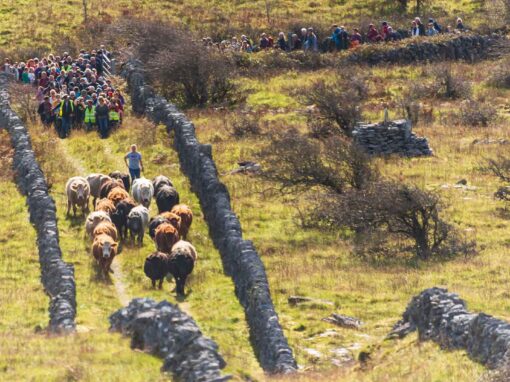The Burren and Cliffs of Moher Geopark Located on the west coast of Ireland, has an area of 530 km2, it is bounded by Atlantic coastal cliffs (10-214 m high) to the west, the Gort lowlands to the East and by low hilly terrain to the south. The geological landscape is one of glacially smoothed Carboniferous (330 million years ago) fossil-rich limestone hills; dramatic sea cliffs; seasonal lakes; and vast networks of subterranean caves. This physical landscape hosts rare natural habitats and unique floral assemblages not found anywhere else on Earth; as well as abundant legacies of human settlement dating back over 6000 years. The Geopark is home to an active network of environmental learning centres, accredited ecotourism businesses, conservation groups, visitor information and interpretation centres, local farm-tours co-operatives, and managed outdoor recreation routes and hubs. Traditional agricultural practices successfully prevail, enabling the conservation of the unique character and biodiversity of the landscape. The collaborative efforts of community-based education, ecotourism, and conservation initiatives are an essential part of the sustainable social, environmental, and economic development of this Atlantic edge region.
Located on the west coast of Ireland, the Burren & Cliffs of Moher UNESCO Global Geopark has an area of 530 km2, it is bounded by Atlantic coastal cliffs (10-214 m high) to the west, the Gort lowlands to the East and by low hilly terrain to the south.The geological landscape is one of glacially smoothed Carboniferous (330 million years ago) fossil-rich limestone hills; dramatic sea cliffs; seasonal lakes; and vast networks of subterranean caves. This physical landscape hosts rare natural habitats and unique floral assemblages not found anywhere else on Earth; as well as abundant legacies of human settlement dating back over 6000 years.Farming (beef and dairy) and tourism are the main industries with the Cliffs of Moher Experience attracting over 1 million people in 2014. Population density is low and dispersed through villages and towns such as Doolin, Corrofin, Ballyvaughan, Lisdoonvarna and Kilfenora.
The Burren & Cliffs of Moher UNESCO Geopark is home to an active network of environmental learning centres, accredited ecotourism businesses, conservation groups, visitor information and interpretation centres, local farm-tours co-operatives, and managed outdoor recreation routes and hubs. Traditional agricultural practices successfully prevail, enabling the conservation of the unique character and biodiversity of the landscape. The collaborative efforts of community-based education, ecotourism, and conservation initiatives are an essential part of the sustainable social, environmental, and economic development of this Atlantic edge region. The Geopark encourages a holistic approach to managing, conserving and promoting the landscape, as each aspect of the environment: geological, ecological, climatic, oceanographic and anthropogenic, is mutually influenced by one another.














